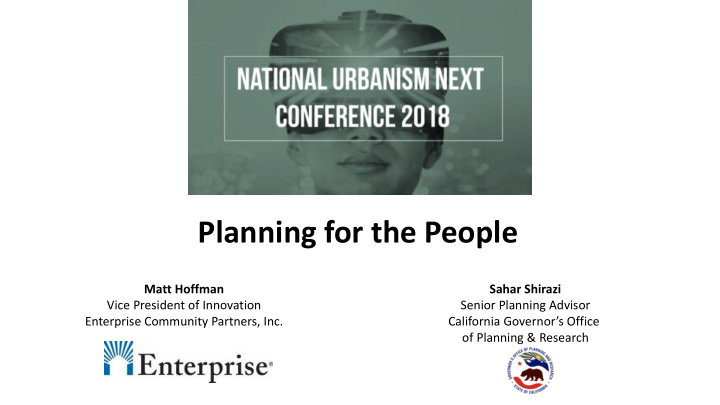



Planning for the People Matt Hoffman Sahar Shirazi Vice President of Innovation Senior Planning Advisor Enterprise Community Partners, Inc. California Governor’s Office of Planning & Research
How will lower income citizens and communities of color be affected by smart cities? Will their lives be better? Worse? How can we make cities more inclusive and equitable on the front end rather than retroactively?
It comes down to 3 basic questions: 1. Who is paying? 2. What makes someone deserving if they cannot pay? 3. What minimum resources should people have by right?
What are we talking about? Who are we talking about? Definition Income Color Disability Age Equitable Fair and impartial Inclusive Not exclusive Accessible Easily obtained and used
Source: CulturalOrganizing.org
Source: InteractionInstitute.org
Source: CulturalOrganizing.org
WaPo: Dec. 28, 2015 69 49 stops stops 6 48 2 9 2 29 5 mins mins mins mins mins mins mins
Fir irst Step Staffing Jobs in in Greater Atla lanta How do we get people to-from jobs? • 87% of First Step’s hours worked lie “outside the perimeter” • 90% of these jobs are not accessible via MARTA How much can people pay? What is the cost to society if they don’t 35% 22% work because they can’t get there? 13% 30% What role is public? 0% What role is private?
Understanding the Reality of Poverty It starts (and stops) with the systems we build!
Areas of Focus for the Equity/Inclusion/Access Lens 4. Health 1. Jobs/Labor 5. Infrastructure 2. Commerce 6. Data 3. Housing
Jobs/Labor When autonomous vehicle saturation peaks, U.S. drivers could see job losses at a rate of 25,000 a month, or 300,000 a year. – Goldman Sachs Economic Research (2017) More than four million jobs will likely be lost with a rapid transition to autonomous vehicles. – Center for Global Policy Solutions: “Stick Shift: Autonomous Vehicles, Driving Jobs, and the Future of Work” (2017)
Commerce
Housing Just because you have a voucher doesn’t mean you can use it Only 20% of those eligible for housing assistance receive it Eligible 25.7mm Recipients 4,690,000 Source: Poverty & Race Research Action Council As of August 2017 14 states protect source of income (SOI) 12 states have some jurisdictions protecting SOI 25 states have nothing!!!!!
Health
Infrastructure Source: regionalequityatlas.org
Data Source: National League of Cities
Recommend
More recommend